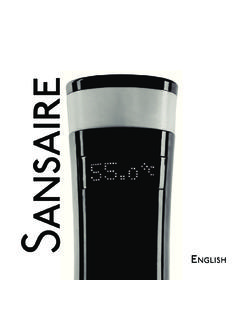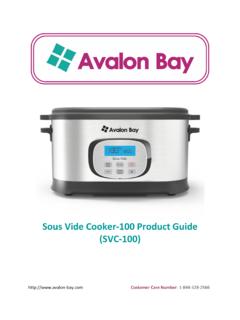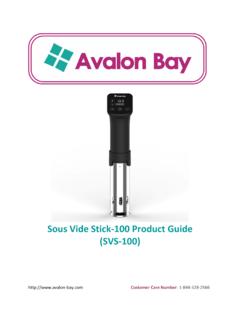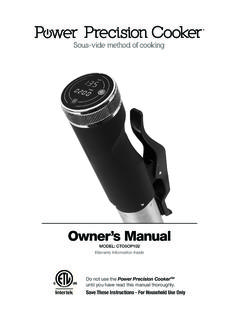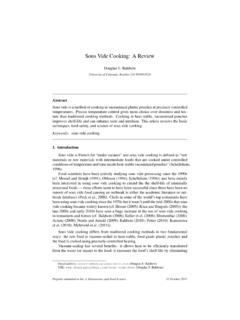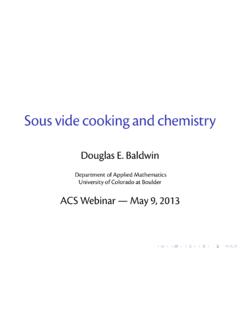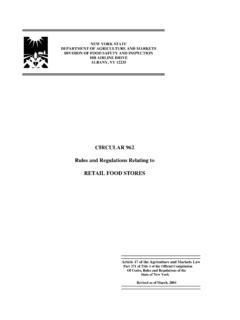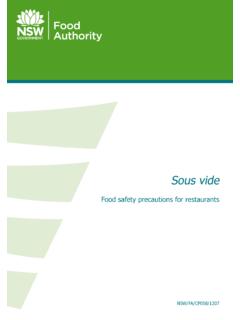Transcription of SOUS VIDE & LOW TEMP COOKING - Stella Culinary
1 sous vide & LOW temp COOKINGJust like stewing and braising started as separate techniques and eventually became one in the same, sous vide and low temperature COOKING are on an accelerated course to follow suit, with the lines between the two already being blurred within our common, Culinary vernacular. sous vide is the French term for under vacuum, meaning any food that is sealed in a vacuum bag is technically sous vide . The confusion arises from the use of immersion circulators, which allow cooks to set a bath to a very precise temperature, accurate to within one tenth of one degree fahrenheit. Food cooked using this method is commonly sealed in a vacuum bag to remove air, which allows the heat from the circulating bath to be conducted more evenly to the food being real magic, however, comes from the precise control an immersion circulator gives a cook.
2 Unlike any other COOKING method, where the temperature is an ever fluctuating variable (except when boiling), an immersion circulator allows the cook to set a precise temperature, yielding a consistent, perfectly cooked product, every time. Just think of what a huge leap forward it is for restaurants to no longer rely on a cook s intuition when trying to serve a medium-rare steak. Now the steak can be pulled from the circulating bath, perfectly cooked, and served to the customer after a few finishing techniques are applied. This, however, doesn t mean there is no art to sous vide , or that skilled cooks are no longer needed. Only with an understanding of COOKING fundamentals can the uniqueness of sous vide be realized, which is why the discussion of this technique was saved for sous vide is considered a wet and slow COOKING technique, it is not simply limited to tough cuts of meat.
3 In fact, there are very few products that can t be enhanced through sous vide COOKING , merely because it allows for such precision, giving the cook complete control over texture and moisture we go into best practices for sous vide , I would like to discuss some common , there is still an alarming amount of professional within the Culinary field who refer to sous vide as a fad. Although I have my suspicions as to why they would make this claim, I am not a mind reader nor a psychologist, so my suspicions are presumptuous at I am, however, is a professional chef who understands the importance of serving a consistent product. In fact, if you were to ask me what makes a restaurant, or any business for that matter, successful, my one word answer would always be consistency.
4 McDonalds isn t successful because they can cook a better hamburger than you, they re successful because they re consistent. Every time you spend a dollar with McDonalds you know exactly what you ll get, for better or worse, which ultimately makes it easier to part with that dollar. In fact, get a group of professional cooks together and the conversation will quickly turn into an argument over COOKING technique and procedure. Simple topics like how to crack an egg or mop a floor can lead to screaming matches; (by the way, an egg should always be cracked on a hard flat surface and mopping should be done in a figure eight motion). Let s take a step back from the argument and think about what s really going on; passionate cooks are arguing about the best method to arrive at a quality finished product.
5 Cooks will never argue about what the best temperature to serve a fillet mignon is, (rare to mid-rare), but they will argue about the best method to consistently achieve that result. This is the virtue of sous vide ; it takes the guess work out of COOKING by removing temperature fluctuation as a variable. If you want a mid-rare fillet of beef, simply drop it into a 55 C bath for one hour and you ll achieve a perfectly mid-rare steak, 100% of the time. For any technique allowing for this level of consistency to be called a fad, is simply an ill-informed view point. The fact that professional kitchens will spend thousands of dollars on pots, pans, stoves, and blenders, but don t have a single immersion circulator is mind boggling. Technique is king because consistency is key. Since sous vide allows for such precision COOKING , it s an important technique for any cook to have in their arsenal, and an immersion circulator is one of the most important COOKING tools anyone can that said, being in the opposite camp, which holds up sous vide as the only method of COOKING , is as equally misinformed.
6 Many people think that food can just be placed in a circulating bath, set at the proper temperature, and then return to it at their leisure, as if it will never overcook. And while that s technically correct, (the food will never rise above the temperature at which the water bath is set), if not pulled within the proper time frame, the food will degrade in quality, loosing flavor and forming an undesirable texture. Although sous vide is not the end all, be all of COOKING , it does offer some distinct advantages including: Better flavor retention. Since most sous vide items are sealed in a bag, the flavors are contained within that environment during the COOKING process, minimizing flavor loss that commonly occurs through seepage and evaporation. More tender proteins.
7 As we discussed in the braising section, when meat is held under 120 F/50 C for a prolonged period of time, the same enzymes that impart tenderness and flavorful qualities to meat during dry aging are hyper-activated, which in turn tenderizes the meat and gives it a more complex taste. No more concentric circles of doneness. Order a grilled steak mid-rare at any restaurant, cut it in half, and you ll notice something inevitable occurs; only a portion of the steak is ever really mid-rare. This is because the temperature it was cooked at far exceeded the desired internal temperature of the steak, causing the outside portion to be well done, and the very center still a little on the rare side. With sous vide , food is cooked at (or close to) the temperature which it will be served, yielding an even doneness throughout.
8 Ease of execution. While the preparation of sous vide foods can be extremely involved, there s something to be said about having a steak perfectly cooked and ready to serve. It takes one more variable out of the equation, allowing the cook to focus on other finishing steps like final seasoning, executing side dishes, and presentation. While sous vide gives the cook some pretty big advantages, there are two distinct disadvantages that you should be aware of. The first and most obvious, is that sous vide COOKING is done at temperatures that are much lower than what is needed to cause the Maillard reaction, which is responsible for delicious-meat-browning-flavors. The easy fix for this is to sear the meat either before or after the sous vide process, or better yet, both. The second disadvantage, which is a common reason people claim to not like food cooked sous vide , is uniformity of texture.
9 While sous vide food done improperly can be mushy, a lot of people prefer the differing textures of classically cooked meat. This uniformity of texture can be easily balanced by adding some crunchy garnishes or components to the dish, or by using a secondary COOKING method right before serving such as frying, searing, or charring on a grill or under a broiler. The fact is, the two biggest objections to sous vide COOKING can be be solved with the application of a high heat, secondary COOKING method. So in short, unless you re specifically shooting for a subtlety in taste, always sear or brown your sous vide meats to achieve the maximum flavor possible. Because of the control and consistency afforded by sous vide COOKING , immersion circulators and water ovens will become common place in home kitchens, especially as their technology becomes widely available and affordable.
10 This makes sous vide an important technique for any cook to both understand and master. The sooner you adopt sous vide COOKING into your repertoire of techniques, the longer you ll be able to enjoy this massive advantage before it becomes common place. On the following pages are time and temperature charts that can be used as a quick reference when COOKING common foods sous vide . Please note that while there are many different times and temperatures that will result in a well finished product, the ones listed below are those that I find work best for my taste and that of my customers. Please feel free to experiment with different times and temperatures to best suit your Warmed Over Flavor When food is cooked and then exposed to oxygen, the flavors can start to break down and become stale, giving off an old or reheated flavor.
